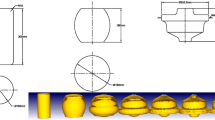Abstract
The physically-based internal state variable (ISV) models were used to describe the changes of dislocation density, grain size, and flow stress in the high temperature deformation of titanium alloys in this study. The constants of the present models could be identified based on experimental results, which were conducted at deformation temperatures ranging from 1093 K to 1303 K, height reductions ranging from 20% to 60%, and the strain rates of 0.001, 0.01, 0.1, 1.0, and 10.0 s−1. The physically-based internal state variable models were implemented into the commercial finite element (FE) code. Then, a three-dimensional (3D) FE simulation system coupling of deformation, heat transfer, and microstructure evolution was developed for the blade forging of Ti-6Al-4V alloy. FE analysis was carried out to simulate the microstructure evolution in the blade forging of Ti-6Al-4V alloy. Finally, the blade forging tests of Ti-6Al-4V alloy were performed to validate the results of FE simulation. According to the tensile tests, it is seen that the mechanical properties, such as tensile strength and elongation, satisfy the application requirements well. The maximum and minimum differences between the calculated and experimental grain size of primary α phase are 11.71% and 4.23%, respectively. Thus, the industrial trials show a good agreement with FE simulation of blade forging.
Similar content being viewed by others
References
Z.M. Hu, J.W. Brooks, and T.A. Dean, Experimental and theoretical analysis of deformation and microstructural evolution in the hot-die forging of titanium alloy aerofoil sections, J. Mater. Process. Technol., 88(1999), No.1–3, p.251.
H. Ou and C.G. Armstrong, Die shape compensation in hot forging of titanium aerofoil sections, J. Mater. Process. Technol., 125–126(2002), p.347.
H. Ou, C.G. Armstrong, and M.A. Price, Die shape optimisation in forging of aerofoil sections, J. Mater. Process. Technol., 132(2003), No.1–3, p.21.
H. Ou, J. Lan, C.G. Armstrong, and M.A. Price, An FE simulation and optimisation approach for the forging of aeroengine components, J. Mater. Process. Technol., 151(2004), No.1–3, p.208.
H. Ou and C.G. Armstrong, Evaluating the effect of press and die elasticity in forging of aerofoil sections using finite element simulation, Finite Elem. Anal. Des., 42(2006), No.10, p.856.
B. Lu, H. Ou, C.G. Armstrong, and A. Rennie, 3D die shape optimisation for net-shape forging of aerofoil blades, Mater. Des., 30(2009), No.7, p.2490.
C. Lv, L.W. Zhang, Z.J. Mu, Q.A. Tai, and Q.Y. Zheng, 3D FEM simulation of the multi-stage forging process of a gas turbine compressor blade, J. Mater. Process. Technol., 198(2008), No.1–3, p.463.
P.F. Bariani, S. Bruschi, and T. Dal Negro, Integrating physical and numerical simulation techniques to design the hot forging process of stainless steel turbine blades, Int. J. Mach. Tools Manuf., 44(2004), No.9, p.945.
Z.M. Hu and T.A. Dean, Aspects of forging of titanium alloys and the production of blade forms, J. Mater. Process. Technol., 111(2001), No.1–3, p.10.
J. Lin and J.B. Yang, GA-based multiple objective optimization for determining viscoplastic constitutive equations for superplastic alloys, Int. J. Plast., 15(1999), No.11, p.1181.
J. Lin and F.P.E. Dunne, Modelling grain growth evolution and necking in superplastic blow-forming, Int. J. Mech. Sci., 43(2001), No.3, p.595.
B.H. Cheong, J. Lin, and A.A. Ball, Modelling of hardening due to grain growth for a superplastic alloy, J. Mater. Process. Technol., 119(2001), No.1–3, p.361.
J. Lin, B.H. Cheong, and X. Yao, Universal multi-objective function for optimising superplastic-damage constitutive equations, J. Mater. Process. Technol., 125–126(2002), p.199.
J. Lin, Y. Liu, D.C.J. Farrugia, and M. Zhou, Development of dislocation-based unified material model for simulating microstructure evolution in multipass hot rolling, Philos. Mag., 85(2005), No.18, p.1967.
Z.C. Sun, H. Yang, G.J. Han, and X.G. Fan, A numerical model based on internal-state-variable method for the microstructure evolution during hot-working process of TA15 titanium alloy, Mater. Sci. Eng. A, 527(2010), No.15, p.3464.
J. Luo, M.Q. Li, X.L. Li, and Y.P. Shi, Constitutive model for high temperature deformation of titanium alloys using internal state variables, Mech. Mater., 42(2010), No.2, p.157.
H. Mecking and U.F. Kocks, Kinetics of flow and strain-hardening, Acta Metall., 29(1981), No.11, p.1865.
R.C. Picu and A. Majorell, Mechanical behavior of Ti-6Al-4V at high and moderate temperatures: Part II. Constitutive modeling, Mater. Sci. Eng. A, 326(2002), No.2, p.306.
Author information
Authors and Affiliations
Corresponding author
Additional information
This work was financially supported by the National Natural Science Foundation of China (No.50975234) and China Postdoctoral Science Foundation (No.20110491685).
Rights and permissions
About this article
Cite this article
Luo, J., Wu, B. & Li, Mq. 3D finite element simulation of microstructure evolution in blade forging of Ti-6Al-4V alloy based on the internal state variable models. Int J Miner Metall Mater 19, 122–130 (2012). https://doi.org/10.1007/s12613-012-0526-1
Received:
Revised:
Accepted:
Published:
Issue Date:
DOI: https://doi.org/10.1007/s12613-012-0526-1



